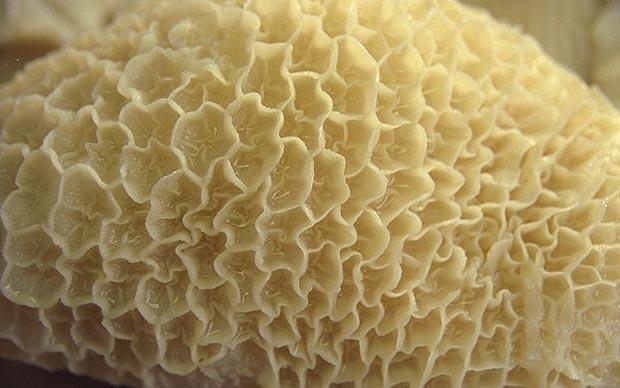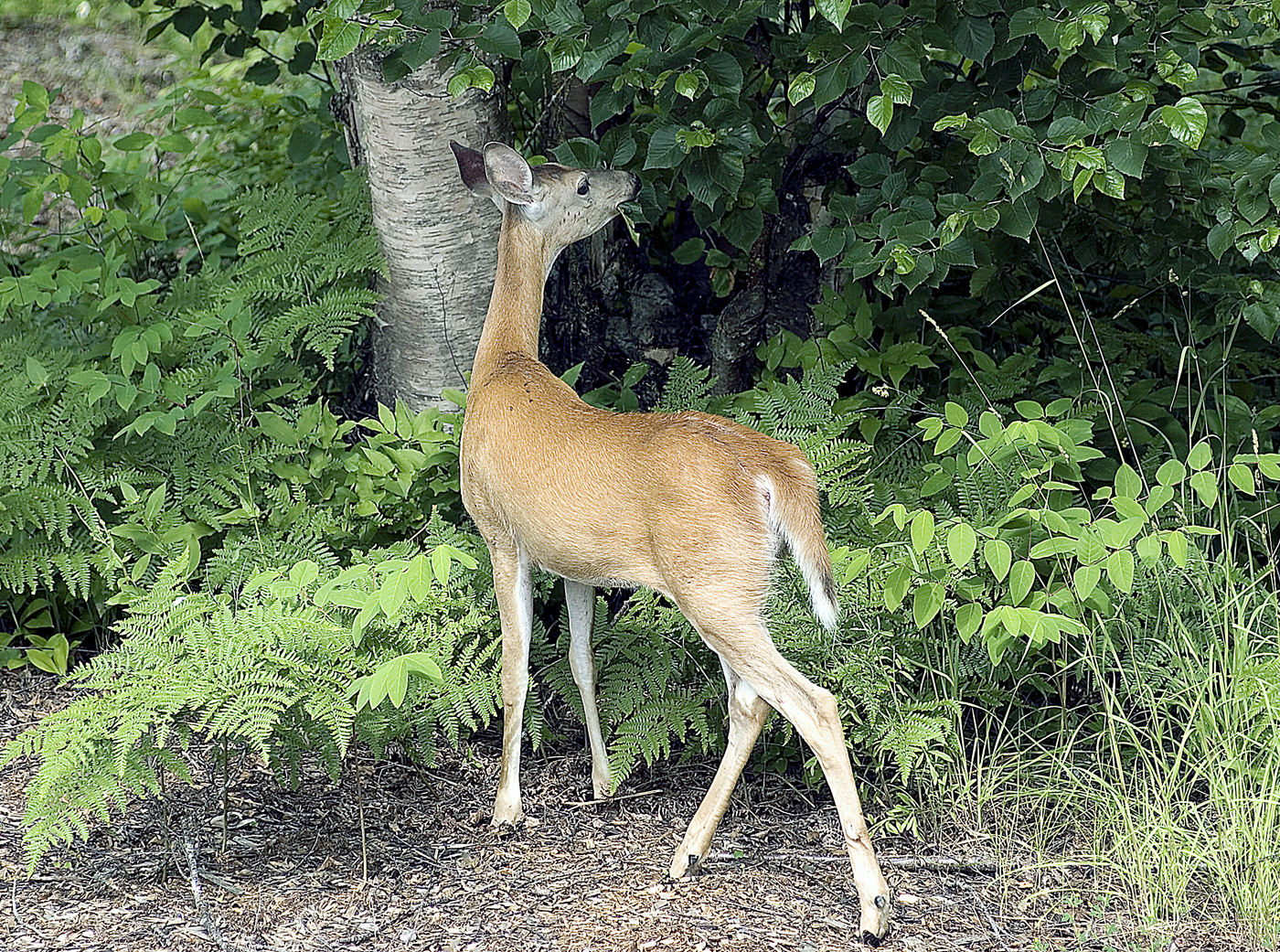|
Reticulum (anatomy)
The reticulum is the second chamber in the four-chamber alimentary canal of a ruminant mammal. Anatomically it is the smaller portion of the reticulorumen along with the rumen. Together these two compartments make up 84% of the volume of the total stomach. The reticulum is colloquially referred to as the ''honeycomb'', ''bonnet, or ''kings-hood''. When cleaned and used for food, it is called "tripe Tripe is a type of edible lining from the stomachs of various farm animals. Most tripe is from cattle and sheep. Types Beef Beef tripe is made from the muscle wall (the interior mucosal lining is removed) of a cow's stomach chambers: th ...". Heavy or dense feed and foreign objects, such as pieces of metal will settle here. It is for this reason that it was nicknamed in Irish as () or ('stomach of farthings'). It is the site of hardware disease in cattle, and because of the proximity to the heart this disease can be life-threatening. Anatomy The internal mucosa ... [...More Info...] [...Related Items...] OR: [Wikipedia] [Google] [Baidu] [Amazon] |
Abomasum (PSF)
The abomasum, also known as the maw,The Chambers Dictionary, Ninth Edition, Chambers Harrap Publishers, 2003 rennet-bag, or reed tripe, is the fourth and final stomach compartment in ruminants. It secretes rennet, which is used in cheese creation. The word ''abomasum'' (''ab-'' "away from" + ''omasum'' "intestine of an cattle, ox") is from Neo-Latin and it was first used in English language, English in 1706. It is possibly from the Gaulish language. Function The abomasum's normal anatomical location is along the ventral midline. It is a secretion, secretory stomach similar in anatomy and function to the monogastric stomach. It serves primarily in the acid hydrolysis of microbe, microbial and dietary pro ...[...More Info...] [...Related Items...] OR: [Wikipedia] [Google] [Baidu] [Amazon] |
Hardware Disease
Hardware disease in livestock is traumatic puncture of the gastrointestinal tract with resultant spread of infection, caused by ingestion of a sharp, hard object, usually a piece of hardware (hence the name). These pieces of metal settle in the reticulum and can irritate or penetrate the lining. It is most common in dairy cattle, but is occasionally seen in beef cattle. It is very rarely reported in any other ruminants. It can be difficult to conclusively diagnose, but can be prevented by the oral administration of a magnet around the time that the animal reaches the age of one year. Depending on where the infection spreads, the medical names for it include bovine traumatic reticuloperitonitis and bovine traumatic reticulopericarditis. Causes Cattle commonly swallow foreign objects, because they do not use their lips to discriminate between materials and they do not completely chew their feed before swallowing. Sharp metallic objects, such as nails, barbed or baling wire ... [...More Info...] [...Related Items...] OR: [Wikipedia] [Google] [Baidu] [Amazon] |
Mammal Anatomy
A mammal () is a vertebrate animal of the class Mammalia (). Mammals are characterised by the presence of milk-producing mammary glands for feeding their young, a broad neocortex region of the brain, fur or hair, and three middle ear bones. These characteristics distinguish them from reptiles and birds, from which their ancestors diverged in the Carboniferous Period over 300 million years ago. Around 6,640 extant species of mammals have been described and divided into 27 orders. The study of mammals is called mammalogy. The largest orders of mammals, by number of species, are the rodents, bats, and eulipotyphlans (including hedgehogs, moles and shrews). The next three are the primates (including humans, monkeys and lemurs), the even-toed ungulates (including pigs, camels, and whales), and the Carnivora (including cats, dogs, and seals). Mammals are the only living members of Synapsida; this clade, together with Sauropsida (reptiles and birds), constitutes ... [...More Info...] [...Related Items...] OR: [Wikipedia] [Google] [Baidu] [Amazon] |
Methanogens In Digestive Tract Of Ruminants
Methanogens are a group of microorganisms that produce methane as a byproduct of their metabolism. They play an important role in the digestive system of ruminants. The digestive tract of ruminants contains four major parts: rumen, reticulum, omasum and abomasum. The food with saliva first passes to the rumen for breaking into smaller particles and then moves to the reticulum, where the food is broken into further smaller particles. Any indigestible particles are sent back to the rumen for rechewing. The majority of anaerobic microbes assisting the cellulose breakdown occupy the rumen and initiate the fermentation process. The animal absorbs the fatty acids, vitamins and nutrient content on passing the partially digested food from the rumen to the omasum. This decreases the pH level and initiates the release of enzymes for further breakdown of the food which later passes to the abomasum to absorb remaining nutrients before excretion. This process takes about 9–12 hours. Some of t ... [...More Info...] [...Related Items...] OR: [Wikipedia] [Google] [Baidu] [Amazon] |
Browsing (herbivory)
Browsing is a type of herbivory in which a herbivore (or, more narrowly defined, a folivore) feeds on leaves, soft Shoot (botany), shoots, or fruits of high-growing, generally woody plants such as shrubs. This is contrasted with Grazing (behaviour), grazing, usually associated with animals feeding on grass or other lower vegetations. Alternatively, grazers are animals eating mainly grass, and browsers are animals eating mainly non-grasses, which include both woody and herbaceous Dicotyledon, dicots. In either case, an example of this dichotomy are goats (which are primarily browsers) and Domestic sheep, sheep (which are primarily grazers). Browse The plant material eaten is known as ''browse'' and is in nature taken directly from the plant, though owners of livestock such as goats and deer may cut twigs or branches for feeding to their stock. In temperate regions, owners take browse before leaf fall, then dry and store it as a winter feed supplement. In time of drought, herdsme ... [...More Info...] [...Related Items...] OR: [Wikipedia] [Google] [Baidu] [Amazon] |
Grazing (behaviour)
Grazing is a method of eating, feeding in which a herbivore feeds on low-growing plants such as grasses or other multicellular organisms, such as algae. Many species of animals can be said to be grazers, from large animals such as Hippopotamus, hippopotamuses to small aquatic Snail, snails. Grazing Ethology, behaviour is a type of List of feeding behaviours, feeding strategy within the ecology of a species. Specific grazing strategies include Graminivore, graminivory (eating grasses); coprophagy (producing part-digested pellets which are reingested); pseudoruminant (having a multi-chambered stomach but not chewing the cud); and grazing on plants other than grass, such as on marine algae. Grazing's ecological effects can include redistributing nutrients, keeping grasslands open or favouring a particular species over another. Ecology Many small selective herbivores follow larger grazers which skim off the highest, tough growth of grasses, exposing tender shoots. For terrestrial a ... [...More Info...] [...Related Items...] OR: [Wikipedia] [Google] [Baidu] [Amazon] |
Farthing (Irish Coin)
The farthing (d) () was the lowest value coin of the pre-decimal Irish pound, worth a quarter of a penny, of a shilling or of a pound. The coin had lost much of its value through inflation long before decimalisation in 1971, and during the 1960s no farthings were produced for general circulation; those minted in 1966 were produced for collectors' sets. The coins officially measured in diameter and weighed 2.83495 grams ( oz). The bronze coin is (was) made up of 95.5% copper, 3% tin and 1.5% zinc. It was introduced in 1928 to replace the British farthing and ceased to be legal tender on 1 August 1969. As the Irish pound was pegged to the British pound until 1979, the Irish farthing had the same dimensions and weight as the British version. The reverse design featuring a woodcock was by English artist Percy Metcalfe. The obverse featured the Irish harp. From 1928 through 1937 the date was split either side of the harp with the name '' Saorstát Éireann'' circling arou ... [...More Info...] [...Related Items...] OR: [Wikipedia] [Google] [Baidu] [Amazon] |
Alimentary Canal
The gastrointestinal tract (GI tract, digestive tract, alimentary canal) is the tract or passageway of the digestive system that leads from the mouth to the anus. The tract is the largest of the body's systems, after the cardiovascular system. The GI tract contains all the major organs of the digestive system, in humans and other animals, including the esophagus, stomach, and intestines. Food taken in through the mouth is digested to extract nutrients and absorb energy, and the waste expelled at the anus as feces. ''Gastrointestinal'' is an adjective meaning of or pertaining to the stomach and intestines. Most animals have a "through-gut" or complete digestive tract. Exceptions are more primitive ones: sponges have small pores ( ostia) throughout their body for digestion and a larger dorsal pore ( osculum) for excretion, comb jellies have both a ventral mouth and dorsal anal pores, while cnidarians and acoels have a single pore for both digestion and excretion. The huma ... [...More Info...] [...Related Items...] OR: [Wikipedia] [Google] [Baidu] [Amazon] |
Coin Purse
A purse or pouch (from the Latin , which in turn, is from the Greek , ''býrsa'', oxhide), sometimes called coin purse for clarity, is a small money bag or pouch, made for carrying coins. In most Commonwealth countries it is known simply as a purse, while "purse" in the United States usually refers to a handbag. An obsolete variant is a porte-monnaie. "Purse" can also be a synonym to bursary (which has the same origin), i.e. a monetary prize in a competition. History The oldest known purse was found with Ötzi the Iceman who lived around 3,300 BC. Another early example is on Egyptian hieroglyphs, which show pouches worn around the waist. The purse-lid from the Sutton Hoo burial is a very elaborate, probably royal, metalwork cover for a (presumably) leather Anglo-Saxon purse of about 600 AD. In Europe they often showed social status based on the embroidery and quality of the bag. In the 15th century, both men and women wore purses. They were often finely embroidered or o ... [...More Info...] [...Related Items...] OR: [Wikipedia] [Google] [Baidu] [Amazon] |
Irish Language
Irish (Standard Irish: ), also known as Irish Gaelic or simply Gaelic ( ), is a Celtic language of the Indo-European language family. It is a member of the Goidelic languages of the Insular Celtic sub branch of the family and is indigenous language, indigenous to the island of Ireland. It was the majority of the population's first language until the 19th century, when English (language), English gradually became dominant, particularly in the last decades of the century, in what is sometimes characterised as a result of linguistic imperialism. Today, Irish is still commonly spoken as a first language in Ireland's Gaeltacht regions, in which 2% of Ireland's population lived in 2022. The total number of people (aged 3 and over) in Ireland who declared they could speak Irish in April 2022 was 1,873,997, representing 40% of respondents, but of these, 472,887 said they never spoke it and a further 551,993 said they only spoke it within the education system. Linguistic analyses o ... [...More Info...] [...Related Items...] OR: [Wikipedia] [Google] [Baidu] [Amazon] |





